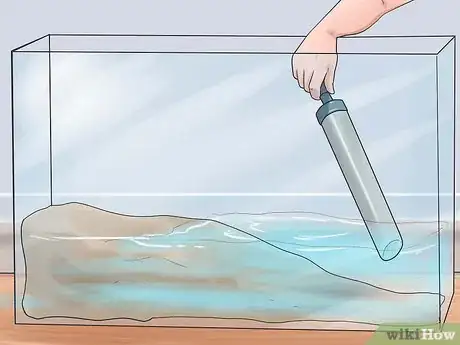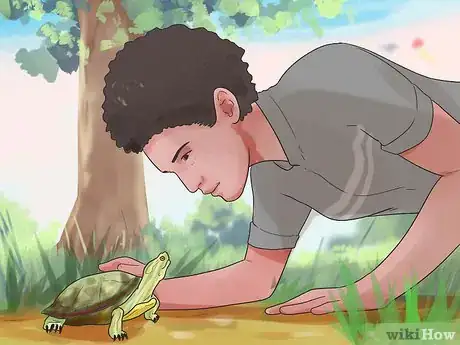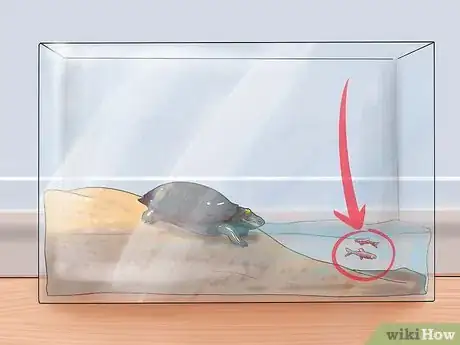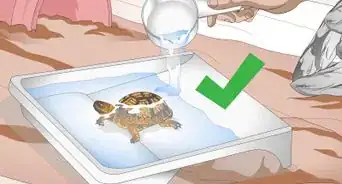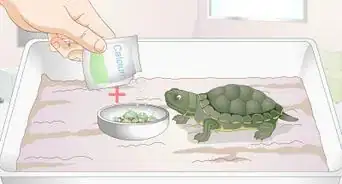This article was co-authored by Audra Barrios. Audra Barrios is a Marine Biologist and owner of Lick Your Eyeballs, a business offering experiemces, reptiles, supplies and plants. With over 15 years of experience, Audra specializes in reptiles and exotic animals, environmental education, marine biology, conservation issues, and animal husbandry. Audra earned a BASc in Marine Biology from the University of California, Santa Cruz, and studied Natural Sciences at the College of Marin. She is the founder and Executive Director of Things That Creep, a non-profit dedicated to herptile conservation through education. She has spent the last nine years working as a biologist at the California Academy of Sciences.
There are 8 references cited in this article, which can be found at the bottom of the page.
wikiHow marks an article as reader-approved once it receives enough positive feedback. This article received 35 testimonials and 86% of readers who voted found it helpful, earning it our reader-approved status.
This article has been viewed 412,580 times.
If you have already purchased a turtle, there are several ways to ensure that your turtle has a long and healthy life. Although turtles require lots of care, a proper diet, and exercise, they are a rewarding pet to have and care for. Keeping them happy is an important step in helping them live a long life.
Steps
Designing a Happy Home
-
1Provide lots of space. Turtles enjoy swimming, basking in the sun, and being active. Turtles also grow. Therefore, providing lots of space for your turtle to enjoy these activities and giving room to grow is important in making your turtle happy.[1] [2]
- Research the potential mature size of your turtle and buy a tank that will reflect his growth. Turtles cannot be crammed into a small space or they will be unhappy.
- Glass aquariums that provide about three to four times the length of the turtle are most desirable. Turtles need to be able to totally submerge themselves and they need an area to get out of the water and get completely dry.
- Keep in mind that the bigger the tank is, the happier the turtle will be. Turtles are reptiles that, surprisingly, have a large territory in the wild. Try to reflect that with a large tank.
-
2Build a beach. Turtles take pleasure from spending time on land and water, so creating an environment that allows them to do both will make them happy. Although turtle aquariums do not need much landscaping creating an appropriate habitat will maximize your turtle’s health and longevity. Designing the habitat can be a fun and creative project, but always remember to keep your turtle’s needs in mind. [3]
- Try to keep the water portion deeper than the shell is wide so your turtle can completely submerge and swim freely.
- Slope the land portion into the water so your turtle does not have trouble entering or exiting the water portion.
- Turtles love to bask in the sun. Create a basking platform so your turtle can enjoy the UVA and UVB heat lamps you set up in the tank.[4] Turtles can relax under the light for up to ten to twelve hours a day.
Advertisement -
3Keep clean. Turtles are messy – they excrete, eat, and leave behind scraps of food in their water. If you do not clean their aquarium and don't have an adequate filter, both the turtle and its habitat will stink.[5] Moreover, all this waste could potentially cause high ammonia and nitrate levels. [6]
- Clean your turtle’s aquarium weekly or create a separate area outside the tank to feed and allow your turtle to excrete waste before reentering the aquarium.
- An unclean tank or turtle could result in several different types of diseases that are difficult to treat.
- Algae will build on your turtle’s shell and will need to be cleaned off with a soft toothbrush.
- Turtles, like most reptiles, shed. The scutes on your turtle’s shell will become itchy and irritable if you do not keep the shell cleaned off.
- Always wash your hands before and after handling your turtle so that you do not transfer germs or contaminates to your turtle and to prevent the transfer of salmonella.
-
4Handle with love. Turtles, like people, have very different personalities. If you have a social turtle, you might be able to pet or play with them, but a general rule would be to keep handling at a minimum. [7]
- In general, turtles do not enjoy being lifted off of the ground, but sometimes it is necessary to remove them from their aquarium for cleaning, playing, or exercise. If so, handle your turtle gently and securely so they do not bite you or try to escape.
- Remember never to put your turtle on its back, grab its tail, or force it out of its shell. Your turtle will not think that is funny and it will stress them out.
- If your turtle enjoys affection, you can pet their head, chin, and shell as long as they allow you to do it.
Eating Healthy
-
1Provide variety. Turtles are omnivores and have a voracious appetite.[8] Just like humans, turtles need variety in their life. A balanced diet of vitamins and minerals is very important to keep your turtle happy and satisfied. [9]
- A balanced diet of leafy green vegetables, insects, and prepared turtle foods will keep your turtle growing to full size. Your turtle might also like fruit or even flowers. Make sure you know what type of turtle you have so that you can provide the appropriate diet.
- Never feed your turtle dairy products, as their stomach cannot properly digest lactose. Also steer clear of giving your turtle processed foods. Whole, dairy free foods are best.
-
2Feed them live food as a snack. Turtles like to chase their food. By providing live food for your turtle, you will give them time for exercise and entertainment. [10]
- Provide your turtle with live crickets, mealworms, wax worms are delicious insects that turtles love to eat.
- Consider adding alternative insects, or even live fish and shrimp, throughout the week to keep your turtle’s diet interesting and nutritious.
-
3Keep a regular schedule. You love your turtle and it loves you, but do not give your turtle food every time you witness begging. Turtles are opportunistic feeders in the wild since they never know when the next meal is coming. Oftentimes, when your turtle sees you they will approach you with an open mouth because they associate you with feeding. Do not veer from the schedule, otherwise you will probably overfeed your turtle. [11]
- Younger turtles need to eat daily whereas adult or mature turtles only need to be fed a few times per week. Be careful not to overfeed your turtle, they can become obese.
- Water should always be accessible. Indeed, many turtles will consume their food under the water, but if they do not, then you should leave your turtle’s food in the same location in the aquarium. That way, your turtle will always know where to go to get their food.
- To help avoid overfeeding, you should present food as your turtle eats it and remove all uneaten or partially eaten food after about five minutes.
Exercising Regularly
-
1Go outside and play. Even if you are a generous owner and purchase an aquarium that provides space and freedom, a turtle will still need additional room to exercise and play. Remember that turtles are extremely active and, in the wild, cover lots of ground despite their unwieldy bodies. [12]
- If you plan to let your turtle out of the aquarium to walk around the house, make sure everybody is aware and that you provide some barriers to control the location of their exercise. This avoids any fatal accidents.
-
2Provide live fish as a game. While in the aquarium, you can place small fish or cuttlebones on top of the water and let your turtle “hunt” these items. The effort your turtle makes to swim and hunt these objects is a great source of exercise. [13]
- Live insects make tasty and hard to catch as well. Consider feeding your turtle mayflies, caddisflies, beetle larvae, crickets, grasshoppers, mealworms, and waxworms.
- Earthworms, blackworms, snails, clams, small frogs, and tadpoles are acceptable mollusks, worms, and amphibians to feed your pet turtle.
- Other natural fish that your turtle would enjoy chasing and eating are red minnows, guppies, and mosquito fish. Do not feed them goldfish as they make harmful chemicals that are dangerous to consume.
-
3Give your turtle toys. Some turtles also enjoy playing. Although it is completely okay to pet and play with your turtle keep in mind that turtles are generally a kind of pet that is better to look at than to constantly handle. They will get stressed out. After all, they are not a dog!
- Consider providing your turtle with an empty shell that they can slide across the floor with or place a small toy raft in their water that they can push along for fun.
- Train your turtle to eat from your hand. This takes some trust and familiarity but once some connection has been established between you and your turtle, try putting a piece of fruit on your hand. If your turtle enjoys this, then try placing the piece of fruit on your wrist so that you turtle has to crawl up your hand to get it.
- Try building an obstacle course. Design obstacles out of your turtle’s natural habitat – stones, sticks, plants, and water pits. Place a treat at the end to provide motivation.
- Another fun game for your turtle is to “find-the-treat.” Hide crickets, worms, or other live insects around your turtle’s habitat for it to find. This will give your turtle a challenge with a treat as a reward.
- Remember that these tricks could take time for your turtle to learn, so be patient. Also, the more difficult the game or the exercise the more stress it will place on your turtle. In other words, it is not a good idea to play these games or exercises on a daily basis.
References
- ↑ Audra Barrios. Marine Biologist & Reptile Specialist. Expert Interview. 18 August 2020.
- ↑ https://www.vetbabble.com/reptiles/turtles/
- ↑ http://pets.petsmart.com/guides/turtles/choosing-the-right-turtle.shtml
- ↑ Audra Barrios. Marine Biologist & Reptile Specialist. Expert Interview. 18 August 2020.
- ↑ Audra Barrios. Marine Biologist & Reptile Specialist. Expert Interview. 18 August 2020.
- ↑ http://pets.petsmart.com/guides/turtles/upkeep-and-maintenance.shtml
- ↑ http://www.petplace.com/article/reptiles/general/enjoying-your-reptile/how-to-handle-turtles-and-tortoises
- ↑ Audra Barrios. Marine Biologist & Reptile Specialist. Expert Interview. 18 August 2020.
- ↑ http://www.vcahospitals.com/main/pet-health-information/article/animal-health/turtles-aquatic-feeding/1075
About This Article
If you want to keep your turtle happy, make sure it has plenty of room to move around on land and in water. Then, even if you’ve given your turtle plenty of room, occasionally take it outside to play and get some exercise. You can also keep your turtle healthy and entertained by feeding it live fish and insects, which it will have to hunt and catch. Sometimes, you can even play with the turtle by hiding food around the aquarium to make them a challenge to find. For advice from our Veterinary reviewer on keeping the turtle healthy, keep reading!



